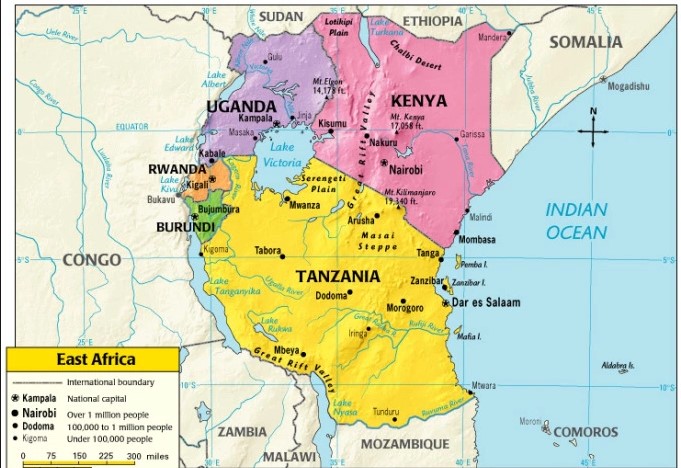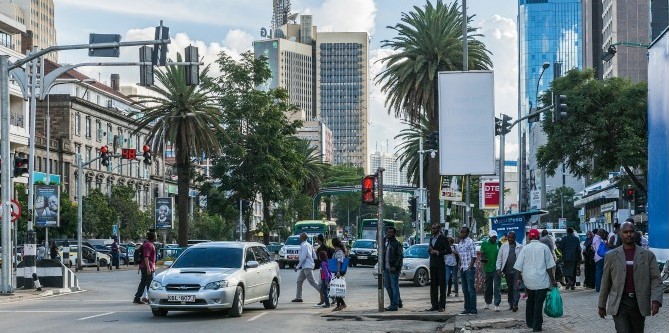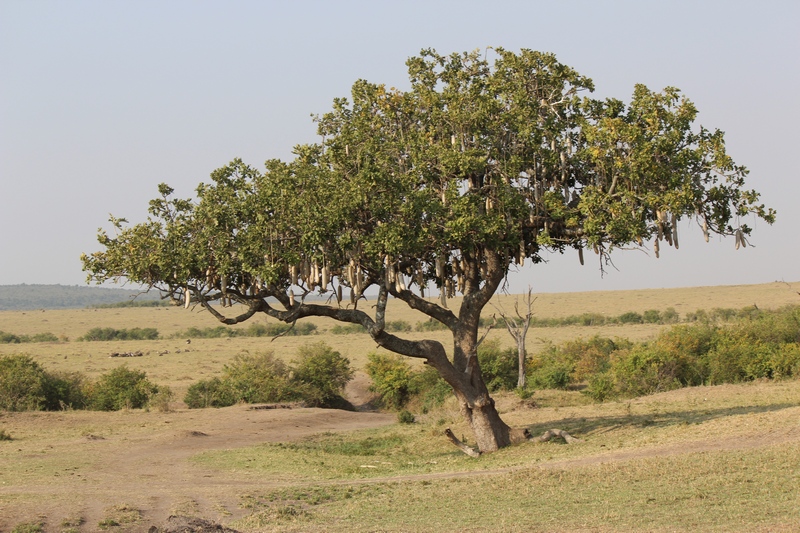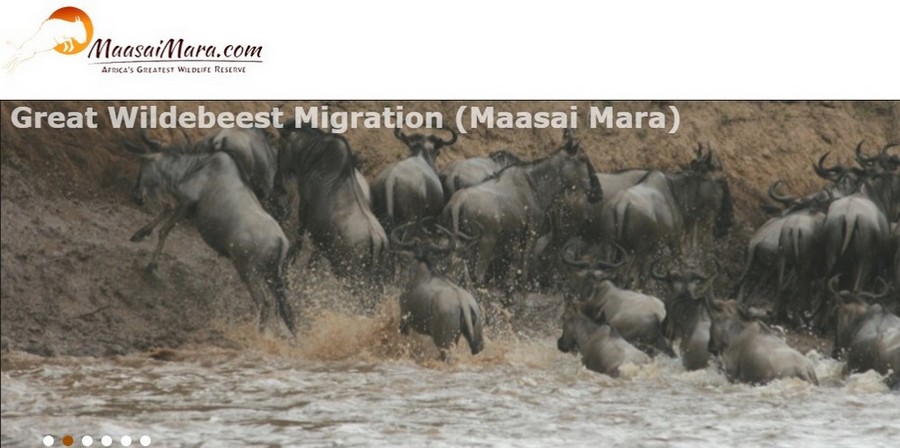

Travelogue
Out of Africa
by Norman Bituin
"JAMBO!" That's "Hello!" in Swahili, the lingua franca in East Africa.
"Out of Africa" was an epic movie drama I remember watching. Based on the memoirs of Karen Blixen, who owned a coffee plantation in Nairobi, British East Africa, it starred Robert Redford and Merryl Streep and won seven Oscar Academy awards including Best Picture in 1985. (Outside Nairobi, our driver-guide pointed to Ngong Hills where the film was shot.) More significantly, "Out of Africa" (OOA) is a paleoanthropological theory which proposes that modern humans evolved in East Africa and then began to disperse throughout the world roughly 50,000 to 100,000 years ago. As someone who has enjoyed reading National Geographic Magazine and watching the National Geographic Channel and Nat Geo Wild for years and dreaming to see the African wildlife in person, Africa was up there in my bucket list.
My wife Cherry and I decided on an 11-day trip in July 2017 in East Africa - Kenya and Tanzania. It was a private tour for two persons operated by Kenya Bush Expeditions with a driver-guide in a safari van. The tour included all accommodations and meals at very comfortable lodges with electricity or generator, bathroom/shower with hot water, and limited wifi. The only thing wild and out of this (our) world were the animals!
We flew Emirates Air with a 20-hour connecting flight in its main hub in Dubai. For long connections, Emirates Air gives a free voucher for hotel and all meals, with airport shuttle. This was an opportunity for us to see the city with the world's largest mall and the world's tallest building even if just for a day.
Dubai, United Arab Emirates
Flight visual from Emirates Air tv screen, LA to Dubai non-stop is close to 16 hours.
Dubai Mall, the world's largest, features Jollibee. There are 450,000 Filipinos living in Dubai and they comprise 21% of the city's population.
There is no tax on personal and rental income, capital gains or inheritance. If you earn $3,000 that's what you'll see on your pay check, I was told.
(After I took this picture, the Kuwaiti man pushing a baby stroller lined up at the counter to buy his favorite Jollibee item).
*We were met in Dubai by Cherry's niece, Jam, a nurse and a sister of Brod Jimboy Tambaoan'16. *Burj Khalifa at night.
Left picture, l-r: Lala, a friend and an architect; Jam; Cherry; and Jam's aunt on her mother's side, Amy, also a nurse.
Tickets to Burj Khalifa's At The Top observation decks: Floor 124 is $34, Floor 148 is $95.
The view from Floor 124 on a hot hazy morning.
Burj Khalifa built at a cost of $1.5 billion in 2004 is the world's tallest freestanding structure with 163 stories and measures 2,722 feet to the tip.

I. Kenya
Nairobi
Flight visual from Emirates Air tv screen, Dubai to Nairobi is 5 hours.

Modern Nairobi
[This is an online photo.]
Unfortunately, our African trip started very badly. We were robbed! Arriving on a Tuesday night, a representative from the tour company picked us up to bring us to the hotel. As we were passing through a rough area in downtown Nairobi in heavy traffic, one man banged on one door to distract us while another man opened the other door. In a few seconds, he had grabbed and ran away with Cherry's purse. In the purse were her passport, iPhone, cash, driver's license, credit and ATM cards. It's still a mystery how he opened the door because the rep said he had automatically locked the doors. The owner-president of Kenya Bush Expeditions came and brought us to the Central Police Station to file a report. Cherry spent the night calling the bank and the phone and credit card companies in the US. The next day (supposed to be a rest day with a complimentary city tour), the owner accompanied us to the US Embassy. After three hours of processing, the Embassy issued her a temporary passport. We were still thankful that this happened in the capital city of Nairobi where there is a US Embassy and it was during the work week. At the start of the safari the following day, Joseph Mutitu, our driver-guide who was told of our Kenyan "welcome" and who is a Christian, said it best - "Things happen for a reason that we don't understand. Forget this happened and enjoy the safari". Amen. And we did. As they say - "Hakuna matata" (No worries).
Joseph Mutitu is a jovial and knowledgeable person who has two college degrees - engineering and tourism.
He chose the latter for his career and has been in the travel industry for 20 years, 12 years with this company.
According to Joseph, many people walk from their villages, which could be a few kilometers, to work in the city.
Kids walking to school is a common and heartwarming sight. They look so curious and friendly and always wave to the people in passing vehicles.
Some animals want to share the national highway.
The Great Rift Valley is a geographic trench formed 35 million years ago that runs from Lebanon's Beqaa Valley in Asia to Mozambique in South Eastern Africa.
East African Rift is called the “cradle of humanity.” Hominid skeletons of “Lucy,” 3.2 million years old, and “Turkana Boy”, 1.5 million years old, were unearthed here.
On the roadside, a lady sells fresh produce of red onions, tomatoes and potatoes while we take a break.
We bought inexpensive but beautiful paintings and silkscreens done by the Maasai people at a couple of these curio shops.
A few weeks before the national elections on August 8, political rallies and billboards dominated the scene.
Bumpy, dusty roads going to the interior may be a good business (or not) for a car wash.
After five hours on the road, we finally got to our first stop at the AA Lodge Maasai Mara.
Maasai Mara National Reserve
Maasai women try to sell their souvenir items to visitors.
The safari vans have a pop-up roof for better viewing and picture-taking.
The lion is one of Africa's "Big Five".
The other four are the leopard, the elephant, the cape buffalo and the rhinoceros.

Poisonous to humans, the fruits of the Kigelia Africana or "sausage" tree are eaten by baboons, impalas and bush pigs.
Its many uses: to make traditional beer, treat skin sores and ulcers, relieve a toothache, and extracts for cosmetics and lotions.
The cheetah is one of Africa's "Super Seven". The "Super Seven" is the "Big Five" plus the cheetah and the hyena.
Taking a shot at the sunset in Maasai Mara.
The cape buffalo is one of Africa's "Big Five".
Kenyan school kids enjoy their field trip to the National Reserve.
This stone marker is the safari border between Tanzania and Kenya.

The mass migration from the Serengeti in Tanzania to the Maasai Mara in Kenya crosses the Mara River from July to October and includes about
1.7 million wildebeests, 400,000 Thomson's gazelles, 300,000 zebras and 12,000 elands. Crocodiles wait for them in the water and the big cats on land.
The park rangers said they would cross for 2-3 hours and another crossing might follow in another day or two. One has to be there at the right day and
the right time to witness it. The last crossing was two days ago and we saw a number of bloated animals in the river with the crocodiles feeding on them.
Aggressive and territorial, the hippopotamus is responsible for more human fatalities in Africa than any other large animal. On Aug. 11, 2017
Carole Kirken, 75, a registered nurse from Detroit, was killed by a hippo while on her dream safari with her grandson in Tanzania.
Lake Naivasha
Lake Naivasha is home to a variety of types of wildlife including over 400 different species of birds and a sizeable population of hippos.
Sitting early evening at the cottage porch with heavy rain falling, I think of the 80's song "Africa" by Toto --
"I bless the rains down in Africa. Gonna take some time to do the things we never have."
Visit to a Maasai Village
We pose for a picture with the village chief, Leshand.
The Maasai men and women line up for the welcome song and dance. "Maa" is the language. They are a semi-nomadic people living in Kenya and Tanzania.
Killing a lion brought status to the Maasai, but is now banned. Lions mauling livestock are hunted though a government compensation is offered instead.
"Shuka" is the colorful sheet wrapped around the body. The women weave and bead jewellery. Sandals are made from cow hide.
The men do the "adumu" or "jumping dance" which I try to copy poorly as they encourage me.
The chief's wife gives her necklace for Cherry to wear as they do the "adumu". In one village, the chief has 25 wives; in another, the chief has 18 wives.
The number of one's cattle (50 is respectable) and the number of one's children are the measures of wealth in the Maasai society.
The village is enclosed with a circular fence of thorned acacia to protect them and their livestock from predators.
Cattle is the traditional food but is now mixed with maize and grains. They also herd sheeps and goats.
The house is formed with timber poles latticed with smaller branches wattle and plastered with a mixture of mud,
sticks, grass, cow dung, human urine and ash. The cow dung ensures that the roof is waterproof.
A warrior shows us his house with what he calls the "Papa room" near the entrance.
The "Mama Room" is where the wife and children sleep, he explains. It is also the kitchen and living room where they store food, cook, eat and socialize.
No matchsticks. One makes fire using friction and passes it to the rest of the tribe.
The "medicine man" shows the cuttings from trees and plants he uses to treat ailments.
All smiles with the beaded hand bracelet I bought as a souvenir.
Amboseli National Park
After six hours driving from Lake Naivasha, we made it to AA Lodge Amboseli.
The elephant is one of Africa's "Big Five".
Capturing travel memories with Sony handycam, Canon 55-250 mm and Leica 25-600 mm.
The hyena is one of the "Super Seven".
Sunset in Amboseli.
II. Tanzania
Tarangire National Park
Crossing the Namanga border in Tanzania, Joseph leaves and passes us to the Tanzanian driver-guide, Beka.
In Tarangire, we stayed at Maramboi Tented Camp with a view of the grazing animals from the swimming pool and the outdoor dining area. To go to the dining area
after dark, you have to call for security escorts who carry a flashlight and a spear as dangerous animals could be roaming around (you don't want to be their meal!).
Serengeti National Park
Passing through towns in Tanzania.
Accidents sometimes happen in the tight and winding mountain roads.
Lobo Wildlife Lodge Tanzania has a panoramic view of the wildlife below, especially near a watering hole, from atop the deck.
Took this picture at full zoom of a lion kill from a distance of about 200 meters.
Further close-up shows not much is left of the kill.
Vultures finish off the carcass of a wildebeest.
The rhinoceros is one of Africa's "Big Five". Quite elusive to spot, our driver-guide said.
Tens of thousands of wildebeests trek to the river following the rain and new grass to the north. This great migration has been happenning for 2.5 million years.
The crocodile (bottom left) waits for the animals to cross.
A zebra jumps in and makes it safely to the other end.
The two wildebeests, emboldened by the zebra, also jump in and make it safely too.
With our Toyota land cruiser quite close, the elephants from this herd coming up from the river look mad and upset as they cover and protect the baby elephant.
Trumpeting loud and appearing ready to charge, they back off when the driver revved the engine and lurched away to the side.
Sunset comes down in the Serengeti.
Lion pride stays cool under the tree shade.
So does this elephant herd.
We finally spot two leopards. This completes our search for Africa's "Big Five" - the lion, leopard, cape buffalo, elephant and rhinoceros.
Others look for Africa's "Super Seven" which is the "Big Five" plus the cheetah and hyena. We got the "Super Seven" too.
Ngorongoro Conservation Area
We got to Ngorongoro after the gate to the Ngorongoro Crater had closed at 4 PM. It was raining the following day and
we still had to travel 8 hours to cross the border and reach Nairobi. From atop the lodge, we could see down on the crater.
Ngorongoro Crater from the vista point on our way earlier to Serengeti National Park.
View of the crater from our room.
View of the crater from the lodge deck.
Inside the Ngorongoro Wildlife Lodge.
Back in Nairobi hotel for dinner before the flight back to "home sweet home" California, USA.
This trip to the African continent was an adventure and a discovery. Exploring East Africa where our common ancestors might have originated before they migrated around the world was a visceral vibe. And to see the thousands and the variety of animals that roam free in the vast land and to join for some moment the Maasai people who live and co-exist with them was both a learning and moving experience.
Below are the modest and beautiful artwork from the Maasai that we brought back. We had framed them and they now hang on our wall. They are truly "Out of Africa" and, to us, will always evoke wonderful images and memories.
ASANTE AFRICA!! Thank you Africa!!